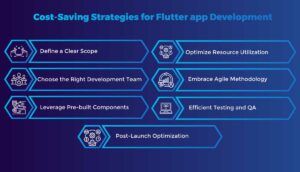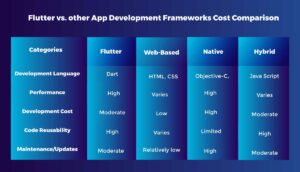Food Delivery App Development solutions
We are empowering the food Delivery industry with cutting-edge technology solutions.
Understanding Flutter App Development Costs: A Guide

Whether you’re a startup or an enterprise, app development cost is a major concern. Flutter app development is a robust and native like framework for creating appealing and intuitive mobile applications. Developed by Google’s tech experts, Flutter has quickly gained favor with businesses and developers. Its key differentiator is its capacity to produce stunning and flawless iOS and Android apps from a single codebase.
If you plan to develop a Flutter application and are wondering about your flutter app development cost & estimation budget, the blog will give you a detailed estimation of the costs involved in developing a Flutter application.
It can be challenging to provide an exact figure without getting into the details of the project needs. The cost of a basic Flutter app development might cost between $10,000 and $30,000, whereas a more intricate and feature-rich one might cost $50,000 or more. The cost estimate and app development change based on the specifics of your project needs.
Several key factors come into play when estimating the cost of developing a Flutter native-like app.
App Complexity
The complexity of your app idea sets the stage for the cost. A simple app with essential features and a straightforward user interface will generally have a lower price tag. On the other hand, if you have ambitious plans involving intricate animations, real-time data synchronization, or advanced AI capabilities, the app development cost will naturally be higher.
UX/UI Design
Design plays a vital role in capturing users’ attention and enhancing their overall experience. The app design cost encompasses various elements, such as UI/UX development, graphic assets, and branding. Investing in a visually stunning design can significantly impact user engagement and contribute to the success of your app.
Backend Development
While Flutter takes care of the front end, the back end is the unseen force that powers your app’s functionality. Factors such as server infrastructure, database integration, user authentication, and third-party API integrations contribute to the development cost. Building a robust and scalable backend ensures your app can handle increasing user demands without breaking a digital sweat.
Testing and Quality Assurance
Ensuring the quality and reliability of your app is a crucial step in the development process. Thorough testing and quality assurance procedures help identify and rectify bugs or glitches before users encounter them. Comprehensive testing guarantees a smooth user experience and safeguards your app’s reputation.
Maintenance and Updates
Once your app is launched, the journey continues with regular maintenance and updates. This process includes operating system updates, bug fixes, and feature enhancements. Neglecting maintenance can lead to a decline in user satisfaction and hinder your app’s growth. So, allocate resources for continual maintenance and improvements.

Define a Clear Scope
Choose the Right Development Team
Leverage Pre-built Components
Optimize Resource Utilization
Embrace Agile Methodology
Efficient Testing and QA
Post-Launch Optimization
It’s important to note that the cost estimation of Flutter app development may vary depending on the specific requirements of your project. Factors such as app complexity, desired features, design intricacy, and development team expertise can all influence the expenses. Working closely with your development team and outlining clear project goals and priorities will help ensure that costs are aligned with your vision and budget.
Cost Factors Description App Concept and Design Includes ideation, wireframing, prototyping, and UI/UX design. Cost varies based on complexity, number of screens, and desired interactivity. Development EffortTurning the app design into a functional reality. Cost depends on features, app logic complexity, and integrations with backend systems or APIs.
Backend Infrastructure Setting up and maintaining the backend infrastructure for data storage, user authentication, server communication, etc. Consider server hosting and database services. Testing and QATesting processes to identify and rectify bugs or issues. Includes manual testing, automated testing frameworks, and device compatibility checks. Deployment and Distribution store submissions, certificate generation, release management, and app store optimization. Allocate resources for marketing efforts.

Now, let’s compare the costs associated with Flutter and other native app development frameworks to see how they stack up against each other
Development Cost of Flutter Application:
Flutter’s single codebase allows developers to write code once and deploy it on iOS and Android platforms. This significantly reduces development time and effort, resulting in cost savings. Additionally, Flutter’s rich set of pre-built UI components and customizable widgets enable faster prototyping and development, further reducing costs.
Maintenance and Updates:
With Flutter development, maintaining and updating your app becomes more streamlined and cost-effective. Since you’re working with a single codebase, bug fixes, feature enhancements, and compatibility updates can be implemented more efficiently, minimizing the associated expenses.
Development Cost of Native App:
Native app development requires separate building codebases for each platform (e.g., Swift for iOS and Java/Kotlin for Android). This increases development time and costs, as developers must write platform-specific code and manage two separate codebases simultaneously.
Maintenance and Updates:
Managing two separate codebases for maintenance and updates requires additional time and effort. Any bug fixes, performance optimizations, or feature enhancements must be implemented separately for each platform, potentially resulting in higher long-term costs.
Development Cost of Hybrid App:
Hybrid frameworks like React Native and Xamarin aim to balance development efficiency and platform-specific features. While they offer code-sharing capabilities, they may require additional efforts to achieve a native-like experience. This can impact development costs, as developers must bridge the gap between the framework and platform-specific requirements.
Maintenance and Updates:
Similar to native app development, hybrid app maintenance, and updates involve managing separate codebases for each platform. This adds complexity and potentially higher long-term costs than Flutter’s single codebase approach.
Development Cost of Web-Based App:
Web-based frameworks like ReactJS and Angular allow developers to create web applications on multiple platforms. While the initial development cost may be lower than native or hybrid approaches, the need for additional customization and optimization for mobile platforms may increase the overall expenses.
Maintenance and Updates:
Web-based apps require continuous updates and compatibility checks across browsers and platforms. This ongoing maintenance can add to the overall costs, especially when ensuring optimal performance on mobile devices.
One of the most common misconceptions about Flutter app development is that it’s an expensive choice for app development. However, let’s shed some light on the reality and debunk this myth
Development Efficiency of the Flutter App:
Flutter’s “write once, run anywhere” approach significantly reduces development time and effort. With a single codebase for multiple platforms, developers can streamline their workflow, eliminate the need for separate teams for iOS and Android, and reduce the overall project complexity. This efficiency translates into cost savings as you save on development resources and time, ultimately lowering the project’s price tag.
UI Customization of the Flutter App:
Creating visually appealing and highly customizable user interfaces is a breeze with Flutter. Its rich set of pre-built UI components, called widgets, allows developers to achieve stunning designs with less effort. This eliminates the need for extensive design work or expensive customizations, making Flutter a cost-effective choice for achieving aesthetically pleasing app interfaces without compromising quality.
Maintenance & Updates of the Flutter App:
Maintaining and updating an app can be costly, but Flutter streamlines this process and makes it more cost-effective. With Flutter’s single codebase, you don’t have to spend resources on managing separate codebases for iOS and Android. Bug fixes, feature enhancements, and updates can be implemented efficiently, reducing maintenance costs.
While Flutter offers compelling cost-saving advantages, it’s essential to consider the unique aspects of your project and align them with your budgetary goals. Factors such as project complexity, team expertise, and specific platform requirements can influence the overall cost-effectiveness of Flutter for your particular case.
Also a good read, Flutter VS Swift: Choose the best Framework for IOS development
The resounding answer is yes! Flutter is a cost-effective choice for app development. With its streamlined development process, efficient maintenance, and successful real-world implementations, Flutter is a budget-friendly option that doesn’t compromise quality or performance.
Now that you have a clearer understanding of the cost breakdown of Flutter app development, you can make informed decisions and invest wisely in your app venture. While cost is an important consideration, focusing on quality, user experience, and long-term success is equally vital.
Partnering with a top Flutter app development company can ensure the quality of applications. Connect with Glasier Inc. to get custom Flutter app development services at cost-effective rates. Contact us today to discuss your project and receive a tailored solution that fits your needs.
Share post:
How To Choose Between SaaS vs PaaS vs IaaS
Outsourcing vs Offshoring Development: Which Is Better for Your Project